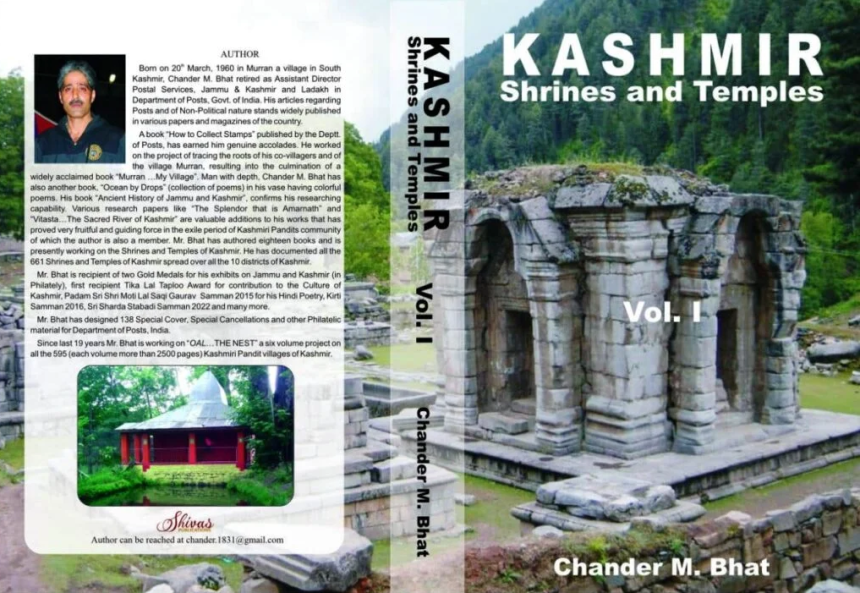BOOK REVIEW
Chander M. Bhat’s “KASHMIR…Shrines and Temples” is much more than a book—it is a labor of love, an epic journey into the heart of Kashmir’s spiritual heritage. This meticulously researched tome offers readers an unparalleled glimpse into the sacred sites scattered across this storied land. With over two decades of rigorous fieldwork and scholarly dedication, Bhat has crafted a work that stands as a definitive guide and an enduring tribute to the region’s rich religious legacy.
The magnitude of Bhat’s undertaking cannot be overstated. Embarking on this project in the early 1990s, at a time when Kashmir was gripped by militancy and upheaval, Bhat’s journey was fraught with danger. The volatile political landscape presented significant obstacles, from local resistance to outright hostility. Yet, driven by a profound reverence for Kashmir’s cultural legacy, Bhat pressed on, navigating rugged terrains and braving numerous perils to document each shrine and temple with the utmost precision.
Bhat’s dedication to this project is evident in the exhaustive detail he provides. Each site is not only described in terms of its historical and cultural significance but also meticulously cataloged with precise coordinates, distances from district headquarters, and current conditions. This level of detail is indicative of Bhat’s commitment to preserving the heritage of these sacred places for future generations.
KASHMIR…Shrines and Temples” is a luminous tapestry, woven with the golden threads of history, culture, and spirituality. Comprising 493 pages, it unfolds like an ancient manuscript, meticulously structured into five distinct sections. Each section is a chapter in the grand epic of Kashmir’s spiritual heritage, inviting readers on a journey through the region’s sacred landscape.
The first section, Ancient Temples, is akin to the roots of a mighty tree, delving into the history of twenty temples that have stood the test of time. These temples are the silent sentinels of an era long past, whispering tales of devotion and resilience. They are the foundation upon which the spiritual edifice of Kashmir is built, offering a glimpse into the architectural and cultural grandeur of ancient times.
Devi Shrines, the second section, is like a garden in full bloom, vibrant with the colors and fragrances of twenty-two shrines dedicated to the divine feminine. These shrines are sanctuaries of grace and power, reflecting the reverence for the goddess in her myriad forms. Each shrine is a petal in the flower of Kashmir’s spiritual garden, contributing to the rich tapestry of its religious traditions.
The third section, Shrines and Temples Linked to Lord Shiva, is the heartbeat of this spiritual journey. Seventeen temples dedicated to the Lord of Transformation stand as testaments to the profound connection between Kashmir and the divine. These temples are the pulse of the region’s spirituality, resonating with the chants and prayers of devotees who seek the blessings of Shiva, the eternal yogi.
In Spring Shrines, the fourth section, we find the lifeblood of Kashmir’s sacred geography. Twenty-six shrines built around natural springs symbolize the confluence of nature and spirituality. These springs, like veins in the earth, nourish the land and its people, offering both physical sustenance and spiritual rejuvenation. They are the living waters that flow through the heart of Kashmir’s spiritual narrative.
The final section, Various Other Sacred Sites, is the horizon of this expansive journey. Nine temples scattered across the region represent the diverse and far-reaching essence of Kashmir’s spiritual heritage. These sacred sites are the stars in the night sky, each one shining with its unique light, contributing to the cosmic mosaic of Kashmir’s religious traditions.
The first volume of “KASHMIR…Shrines and Temples” details over ninety-four temples, offering an in-depth look at their ancient history, geographical context, and current state. Bhat’s descriptions are enriched by his engagement with ancient documents and meticulously maintained revenue records, which provide additional layers of authenticity and historical depth. This scholarly rigor is further complemented by insights from esteemed historians and scholars, whose contributions add valuable perspectives and enhance the overall narrative.
In this luminous tapestry, every thread, every knot, and every hue tells a story. Together, they create a picture of a land where the sacred and the mundane are intertwined, where the past and the present coexist in harmony. “KASHMIR…Shrines and Temples” is not just a book; it is a journey through the soul of Kashmir, an exploration of its spiritual heart, and a celebration of its enduring heritage.
The foreword by Prof. Rattan Lal Hangloo sets the tone for the book, emphasizing the spiritual and historical significance of Kashmir’s sacred spaces. Hangloo’s words lend scholarly weight to Bhat’s work, underscoring its importance in the broader context of Kashmir’s cultural legacy. The endorsement of such a distinguished scholar not only enhances the book’s credibility but also situates it within the larger discourse on Kashmir’s religious and cultural history.
Bhat’s engagement with ancient documents and revenue records is another notable aspect of his work. These invaluable resources provide a glimpse into the rich tapestry of Kashmir’s history and cultural heritage. Bhat’s meticulous analysis of these documents lends authenticity to his narrative and ensures that his work is grounded in historical fact. This scholarly rigor is further complemented by insights from esteemed historians and scholars, whose contributions add valuable perspectives and enhance the overall narrative.
The depth and detail of Bhat’s exploration are truly remarkable. His descriptions of each temple and shrine are comprehensive and meticulously researched. From the ancient temples dedicated to Lord Shiva to the numerous Devi shrines, Bhat provides readers with a rich tapestry of Kashmir’s spiritual landscape. His narrative is further illuminated by his personal observations and experiences, which add a unique and engaging dimension to the text.
Bhat’s ability to weave historical context, geographical details, and personal anecdotes into his descriptions makes for a compelling and informative read. His attention to detail and dedication to accuracy ensure that each entry is not only informative but also engaging and accessible to readers. This meticulous approach allows readers to gain a deeper understanding of the significance of each site and its place within the broader context of Kashmir’s religious heritage.
“KASHMIR…Shrines and Temples” is not merely a catalog of sacred sites; it is a tribute to the rich spiritual heritage of Kashmir. Bhat’s work serves as a testament to the enduring significance of these sacred spaces and their central role in the religious and cultural life of the region. His meticulous documentation ensures that the heritage of these sites is preserved for future generations, offering a valuable resource for scholars, historians, and anyone interested in the spiritual history of Kashmir.
Bhat’s passion for his subject matter is evident throughout the text. His deep reverence for Kashmir’s cultural legacy and his unwavering commitment to preserving it shine through, in every page. This passion, coupled with his scholarly rigor and meticulous attention to detail, makes “KASHMIR…Shrines and Temples” a truly remarkable achievement.
Bhat’s engagement with ancient documents and revenue records is presented with scholarly precision. However, his writing remains accessible, as he explains the relevance and significance of these sources in clear, straightforward language. This balance between scholarly rigor and readability is one of the book’s strengths.
In summary, Chander M. Bhat’s use of descriptive richness, historical context, structured organization, engagement with primary sources, personal reflections, cultural sensitivity, poetic elements, and visual clarity creates a multifaceted and engaging narrative. His style enhances the book’s scholarly value while making it accessible and compelling for a broad audience. “KASHMIR…Shrines and Temples” is a masterful blend of academic rigor and personal passion, offering a profound exploration of Kashmir’s spiritual heritage.
As Bhat continues his work on the second volume, readers can look forward to even more detailed explorations of Kashmir’s sacred sites. His dedication to this project promises further insights and discoveries, contributing to a deeper understanding of the region’s profound spiritual legacy. The anticipation for the next volume is a testament to the significance of Bhat’s work and the impact it has already had on readers and scholars alike.
“KASHMIR…Shrines and Temples” by Chander M. Bhat is a monumental work that stands as both an academic achievement and a heartfelt tribute to the spiritual heritage of Kashmir. Bhat’s dedication, meticulous research, and personal commitment have resulted in a work that is both a scholarly resource and a deeply personal exploration of Kashmir’s sacred spaces. This book is an essential read for anyone interested in the rich cultural and religious history of Kashmir, offering a comprehensive and deeply engaging exploration of its spiritual heritage.
Bhat’s ability to navigate the challenges of documenting these sites, coupled with his scholarly rigor and personal passion, makes “KASHMIR…Shrines and Temples” a truly exceptional work. His detailed and nuanced descriptions provide readers with a rich and immersive experience, allowing them to gain a deeper understanding and appreciation of Kashmir’s spiritual landscape. This book is a valuable contribution to the field of religious and cultural studies and stands as a testament to the enduring significance of Kashmir’s sacred spaces.
(Author is a columnist and can be reached at: [email protected])









